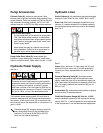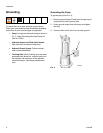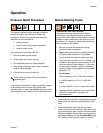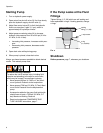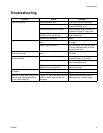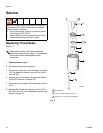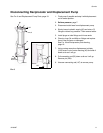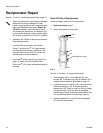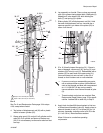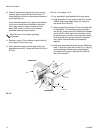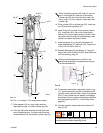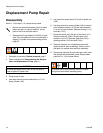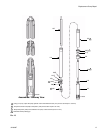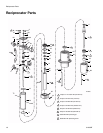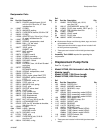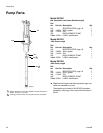
Reciprocator Repair
312350E 13
FIG. 8
See F
IG. 8 and Reciprocator Parts page 18 for steps
4-20, except where noted.
4. Tap bottom of displacement rod (34) with a plastic
mallet to loosen cylinder (25).
5. Grasp valve spool (31) and pull it off cylinder and tie
rods (38). Pull cylinder and piston off bottom cap
(32). It is not necessary to remove tie rods from bot-
tom cap.
6. Lay assembly on its side. Place a clean rag around
yoke (9) to prevent losing detent balls. Slide yoke (9)
sideways off valve sleeve (29) while holding the
balls (7) and spring (6) in place.
7. Slide cylinder (25) off displacement rod (34). Hold
hex end of displacement rod in a vise and use a
spanner wrench in pin holes of the piston (22) to
screw it off the rod.
F
IG. 9
8. (F
IG. 9) Visually inspect the spring (21). If there is
wear or damage, remove nut (18), spring (21) and
retainers (20) from trip rod (12). Reassemble with a
retainer (20) on each end of the new spring (21).
You must thread nut onto rod until it runs out of
thread, so that it bottoms out on rod’s shoulder.
9. Apply fresh Loctite
®
609 thread sealant to first two
or three internal threads of yoke (9). Apply primer to
external threads of rod (12). Let primer dry for 3-4
minutes. Assemble, torquing screw to 54-56 in-lbs
(6.1 to 6.3 N.m). Remove excess sealant.
Allow 24 hours to cure before operating
reciprocator.
3, 39, 2
36, 37
30
31
13*
29
26
6, 7
9
51
12
22
25
24*
23*, 49*
20
21
32
18
20
13*
34
45
17
1
2
2
1
Torque to 40 to 48 ft-lbs (54 to 65 N.m)
Torque to 54 to 56 in-lbs (6.1 to 6.3 N.m)
ti10605a
38
• If you are re-using or reassembling any parts,
use a surface cleaner such as chlorinated sol-
vent on the threads and blow with compressed
air. A 1/4-28 UNF-2A tap can be used to
remove adhesive from internal threads of yoke
(9).
• Thread sealant and primer are required. See
Reciprocator Repair Notes, page 12 for specifi-
cations. Loctite
®
609 is used only in Step 9.
12
20
21
20
18
ti10605a



